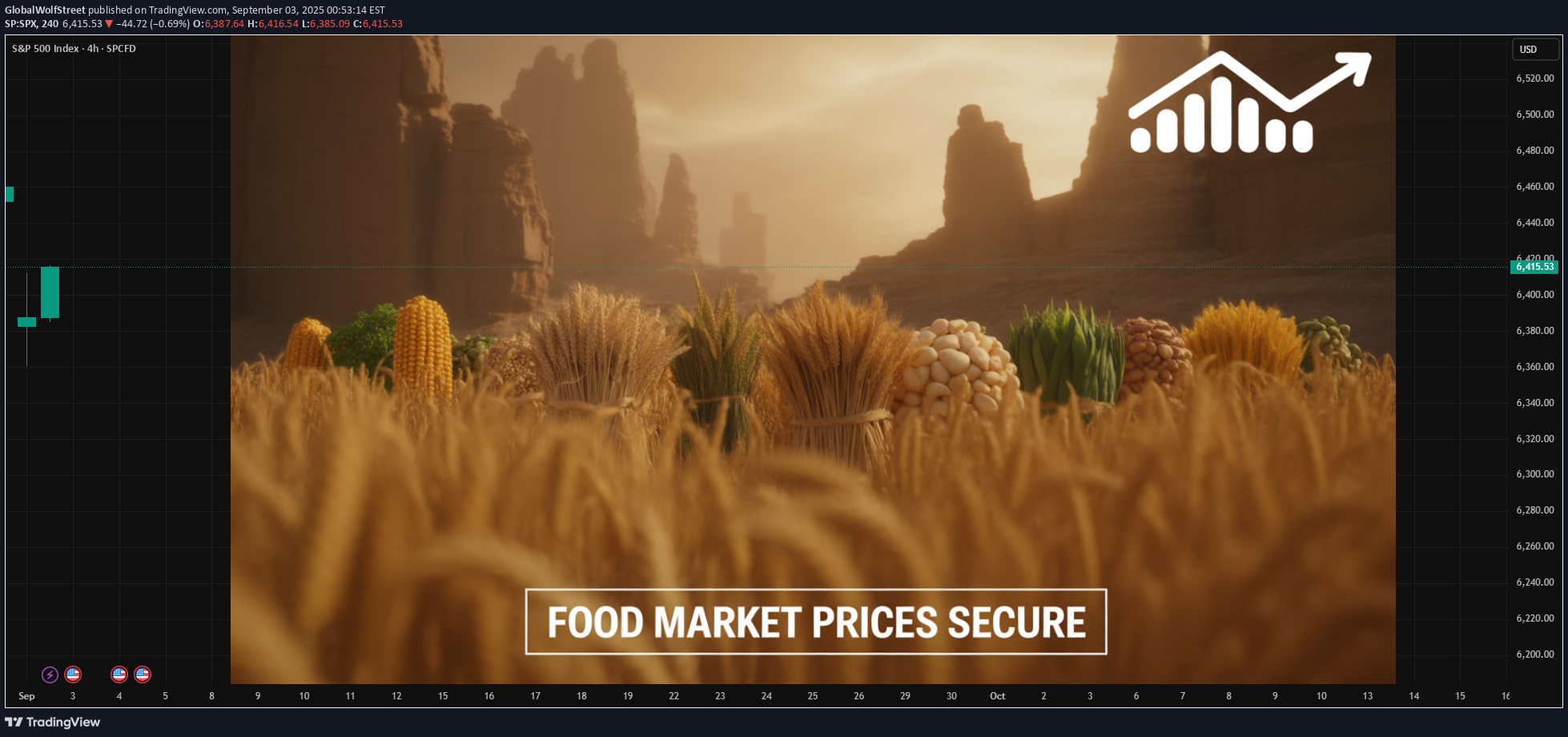تحلیل تکنیکال GlobalWolfStreet درباره نماد SPYX در تاریخ ۱۴۰۴/۶/۱۲

Introduction Food is the most fundamental human need, yet in the 21st century, billions of people still struggle with hunger, malnutrition, and unstable food access. At the same time, global markets heavily influence the price and availability of food commodities such as wheat, rice, corn, soybeans, and edible oils. The link between food security and global market prices has become one of the defining challenges of our era. Food security, as defined by the Food and Agriculture Organization (FAO), exists when all people, at all times, have physical, social, and economic access to sufficient, safe, and nutritious food to meet their dietary needs and food preferences for an active and healthy life. Achieving this requires stability in production, affordability of prices, resilience against shocks, and equitable distribution. Global market prices, meanwhile, are shaped by international trade, supply-demand balances, speculation in commodity markets, climate events, geopolitical conflicts, and policy decisions such as subsidies or export bans. When prices spike, food insecurity rises—especially in poorer countries where households spend a large share of their income on food. This essay explores the intricate relationship between food security and global market prices, examining causes, consequences, and policy responses. Section 1: Understanding Food Security Food security rests on four pillars: Availability – Adequate supply of food from domestic production or imports. Access – Economic and physical access, meaning people can afford and obtain food. Utilization – Proper nutrition, safety, and absorption of food in the body. Stability – Reliable supply and access over time, without major disruptions. Food insecurity emerges when any of these pillars is weak. For instance: A drought may reduce availability. Rising global prices can weaken access. Poor sanitation or lack of dietary diversity can affect utilization. Wars, conflicts, or pandemics disrupt stability. Section 2: The Role of Global Market Prices in Food Security Global markets set benchmarks for staple foods. Prices in Chicago, Paris, or Singapore often determine what wheat, rice, or soybeans cost in Africa, South Asia, or Latin America. Why Prices Matter for Food Security High Prices = More Hunger When global food prices rise, poorer households reduce consumption or switch to less nutritious diets. FAO estimates that the 2007–08 food price crisis pushed more than 100 million people into hunger. Low Prices = Farmer Distress While high prices hurt consumers, very low prices can harm small farmers, reducing their incomes and discouraging future production. This creates a cycle of poverty, migration, and reduced agricultural investment. Price Volatility Unpredictable swings are as harmful as high prices. Farmers cannot plan their crops, governments struggle with food subsidy budgets, and traders hoard supplies, worsening instability. Section 3: Historical Food Price Crises 1. The 1970s Oil Shock & Food Prices Oil price hikes raised fertilizer, transport, and irrigation costs, driving global food inflation. 2. 2007–2008 Global Food Price Crisis Wheat, rice, and maize prices doubled or tripled due to biofuel demand, export bans, and speculation. Riots broke out in more than 30 countries, including Haiti, Egypt, and Bangladesh. 3. 2010–2011 Price Surge (Arab Spring Trigger) Poor harvests in Russia and Ukraine, coupled with droughts, drove wheat prices higher. Food inflation was a key factor fueling protests in Tunisia, Egypt, and across the Arab world. 4. COVID-19 Pandemic (2020–2022) Supply chain disruptions, export restrictions, and labor shortages pushed food prices up. Millions of urban poor in developing countries were hit hardest. 5. Russia–Ukraine War (2022–present) Ukraine and Russia supply 30% of global wheat exports, 20% of maize, and 75% of sunflower oil. The war disrupted Black Sea trade routes, triggering a surge in global grain prices. Section 4: Key Drivers of Global Market Prices Supply & Demand Imbalances Rising demand for meat (China, India) increases feed grain demand. Population growth (expected to reach 10 billion by 2050) pressures supplies. Climate Change & Extreme Weather Droughts in Africa, floods in South Asia, and wildfires in North America reduce output. El Niño and La Niña cycles influence rainfall and crop yields globally. Energy Prices Oil prices affect fertilizer, irrigation, and transport costs. Biofuel policies (e.g., ethanol in the US, biodiesel in Europe) divert grains from food to fuel. Trade Policies Export bans (India on rice, Russia on wheat) reduce global supply and spike prices. Import tariffs and quotas distort markets further. Speculation & Financialization of Commodities Hedge funds and institutional investors increasingly trade food futures. While providing liquidity, speculation can amplify price swings. Geopolitical Conflicts & Wars War zones reduce production (Ukraine) or block exports. Sanctions can disrupt fertilizer supplies (Russia-Belarus potash). Section 5: Food Security Challenges in Different Regions Africa Heavy reliance on imported wheat and rice. Vulnerable to global price shocks due to weak currencies. Climate shocks (drought in Horn of Africa) worsen hunger. Asia India: major producer but also restricts exports during inflation. China: massive food demand, maintains large reserves. Southeast Asia: rice-dependent economies vulnerable to export bans. Middle East & North Africa (MENA) Highly import-dependent (over 50% of food). Price shocks linked to political unrest (Arab Spring). Latin America A food-exporting region (Brazil, Argentina) but faces domestic food inflation. Export crops often prioritized over local food needs. Developed Countries More resilient due to subsidies and safety nets. Still vulnerable to rising food inflation, affecting lower-income households. Section 6: Consequences of Rising Food Prices Hunger & Malnutrition Poor families spend 50–70% of income on food. Rising prices mean reduced meals, more stunting in children. Social Unrest & Political Instability Food riots, protests, and revolutions often follow price spikes. Economic Strain on Governments Higher subsidy bills (India’s food subsidy crosses billions annually). Pressure on foreign reserves for food-importing countries. Migration & Refugee Crises Hunger drives rural-to-urban migration and cross-border displacement. Section 7: Policy Responses to Balance Food Security & Prices Global Cooperation WTO rules to prevent arbitrary export bans. FAO-led initiatives for transparency in food markets. National Policies Price stabilization funds and buffer stocks. Social safety nets: food stamps, cash transfers, subsidized food. Investment in Agriculture Modern farming, irrigation, storage, and logistics. Encouraging climate-resilient crops. Sustainable Practices Reduce food waste (1/3 of global food is wasted). Diversify crops to reduce reliance on wheat/rice/maize. Regional Food Reserves ASEAN rice reserve mechanism. African Union initiatives for emergency grain stocks. Private Sector & Technology Precision farming, AI-driven yield forecasts. E-commerce platforms improving farmer-market linkages. Section 8: The Future – Can We Ensure Food Security Amid Price Volatility? By 2050, food demand will rise by 60–70%. Climate change could reduce yields by 10–25% in some regions. Global interdependence means local crises (Ukraine war, Indian export bans) ripple worldwide. The challenge is balancing farmer incomes, consumer affordability, and global stability. Promising solutions include: Climate-smart agriculture. International grain reserves. Digital platforms for real-time price transparency. Stronger trade cooperation and less protectionism. Conclusion Food security is deeply tied to global market prices. When markets are stable and predictable, people eat well, farmers earn fair incomes, and societies remain peaceful. But when prices spike due to conflict, climate change, or speculation, millions are pushed into hunger and political instability rises. The future demands a balanced approach—ensuring affordable food for consumers, fair returns for farmers, and resilience in supply chains. Global cooperation, sustainable practices, and smart technology will be central to ensuring that food security is not left hostage to market volatility. In short: food is not just a commodity—it is a foundation of human survival, dignity, and global stability.
